High Chair for Older Autistic Child
So, let's talk about providing a comfortable seating solution for older autistic children.
When it comes to ensuring a secure and supportive dining experience, the choice of a high chair plays a pivotal role.
But what specific features should one look for in a high chair designed for this unique demographic?
Join me as we explore the essential considerations and practical strategies to meet the needs of older autistic children during mealtime.
Key Takeaways
- Prioritize safety with a secure 5-point harness and sturdy construction.
- Ensure adjustability for comfort and support tailored to specific needs.
- Consider design features like adjustable trays and footrests for optimal comfort.
- Seek community support for informed decisions on high chairs for older autistic children.
Benefits of Using a High Chair

Why is using a high chair beneficial for older autistic children?
High chairs can be a valuable tool for children with special needs, providing a secure and contained seating arrangement during mealtime. The 5-point harness in these chairs offers essential security and stability, particularly beneficial for children who may have hyperactivity or sensory issues.
Adjustability in high chairs allows for customization to the child's specific requirements, ensuring comfort and support. Additionally, high chairs with trays that are challenging to remove can help prevent disruptions during meals, such as reaching for others' food.
The sturdy construction of these chairs is designed to withstand the weight and movements of older autistic children, promoting safety and stability. Overall, the use of a high chair can create a conducive environment for mealtime, allowing children to focus on eating while feeling secure and supported.
Factors to Consider Before Buying

When looking for a high chair for an older autistic child, it's important to take into account their specific needs, like age-appropriate design features and safety requirements.
Understanding the child's weight and size will help in selecting a chair that can adequately support them.
Prioritizing safety, stability, and adjustability features will guarantee a comfortable and secure seating option for the child.
Age-Appropriate Design Features
When selecting a high chair for an older autistic child, it's essential to prioritize age-appropriate design features that cater to their specific needs and comfort. Here are the key factors I'm looking for:
- Weight Capacity: Consider high chairs with a capacity of around 50-60 pounds to guarantee suitability for older children.
- Adjustability: Look for high chairs with adjustable height and depth to accommodate the child's size and comfort.
- Harness System: Opt for high chairs with a secure harness system to prevent the child from standing or rocking, ensuring their safety and stability.
These features play a crucial role in creating a supportive and comfortable dining environment for older autistic children.
Safety and Stability Requirements
Considering the needs and safety of an older autistic child, it's imperative to prioritize specific factors when selecting a high chair, particularly focusing on safety and stability requirements.
Weight capacity considerations are vital to guarantee the chair can support the child adequately. Look for a high chair with an effective harness system to prevent any accidents or unsafe movements.
Stability concerns shouldn't be overlooked; opt for a chair with a sturdy construction to withstand the child's strength. Safety features like anti-tip design or locking mechanisms add an extra layer of protection during mealtime.
Additionally, prioritize seating comfort and posture support to promote proper positioning and behavior. By addressing these factors, you can make sure a safe and stable mealtime experience for your older autistic child.
Adjustability and Comfort Features
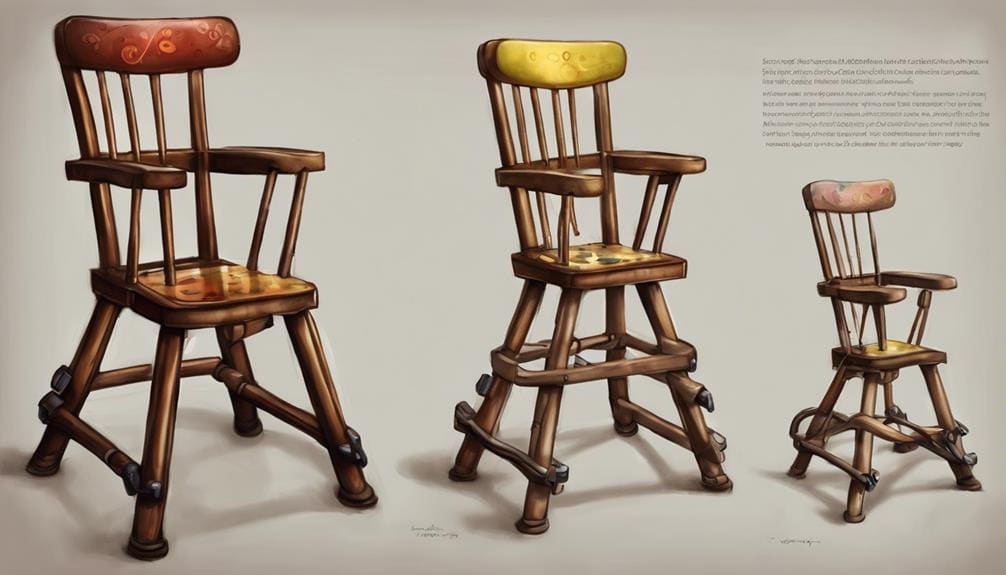
For older autistic children, high chairs featuring adjustable footrests and seat heights can offer tailored comfort and essential support. When selecting a high chair, consider the following key features to assure maximum comfort and adjustability:
- Comfort customization and support stability: Look for high chairs with adjustable trays, backrests, and padded seats to accommodate different seating preferences and provide a comfortable dining experience for older autistic children.
- Ergonomic design and adjustable features: Opt for high chairs with ergonomic designs that promote proper posture and support during meal times. Adjustable features like seat heights and footrests can further enhance comfort and assure a personalized seating experience.
- Washable cushions for hygiene maintenance: High chairs with removable and washable cushions are essential for easy hygiene maintenance, allowing for a clean and comfortable seating option for older autistic children.
Considering these features won't only provide a comfortable and supportive seating solution but also cater to the specific needs of older autistic children during meal times.
Safety Precautions to Keep in Mind
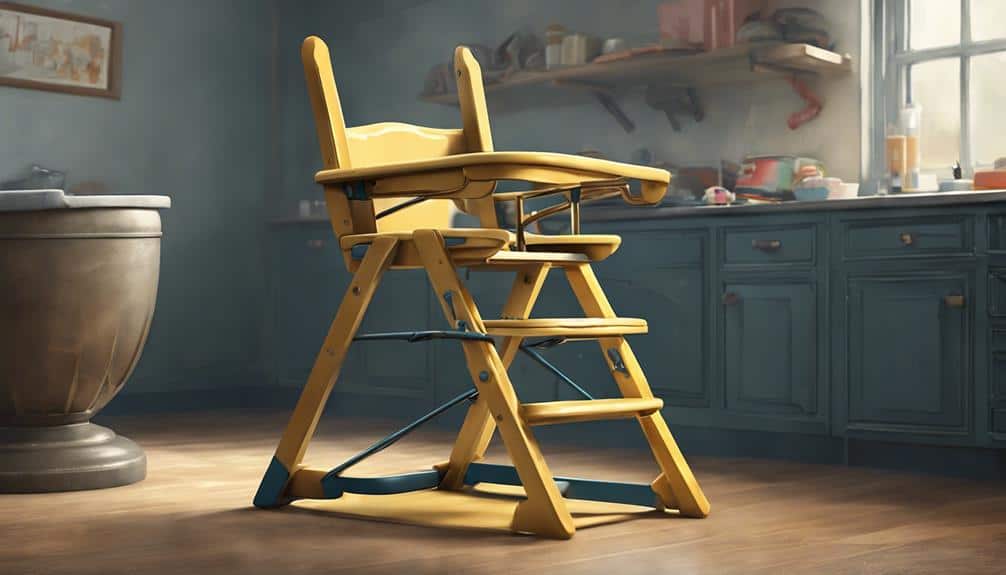
When setting up a high chair for an older autistic child, it's important to secure the straps properly and confirm a sturdy base design for stability. These measures can help prevent accidents and provide a safe seating environment during mealtimes.
Prioritizing safety features like these can go a long way in creating a secure space for the child.
Secure Straps Properly
Properly securing the straps on a high chair is crucial to guarantee the safety of an older autistic child during mealtime. Here are some key points to keep in mind:
- Strap positioning, importance: Make sure the straps are correctly adjusted and placed to prevent excessive movement.
- Securing techniques, tips: Use high chairs with secure 5-point harness systems for maximum stability and support.
- Proper fastening, methods: Follow the manufacturer's guidelines when fastening the straps to minimize the risk of accidents or injuries.
Sturdy Base Design
Ensuring the high chair's base is sturdy and well-designed is fundamental for safeguarding an older autistic child during mealtime. Stability enhancements play a critical role in preventing tipping or rocking, providing a secure dining environment.
Look for slip-resistant features such as non-skid feet or grips on the base to enhance traction and minimize the risk of sliding on smooth surfaces. Opting for durable construction materials like solid wood or metal can offer long-lasting support and resilience to the child's movements.
Selecting a high chair with a weight capacity suitable for older children is vital, ensuring it can securely accommodate the size and needs of the autistic child. Check for reinforced joints and connections to withstand potential challenges posed by an older and potentially stronger autistic child.
Mealtime Strategies for Autistic Children
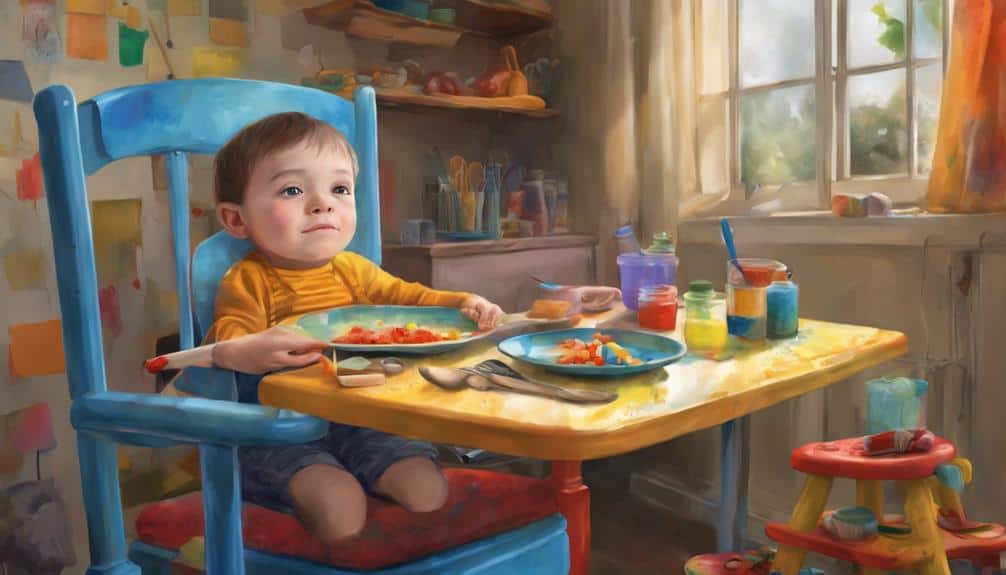
To support older autistic children during mealtime, implementing personalized mealtime strategies tailored to their needs is essential. Here are three key strategies that can make mealtime a more positive and successful experience:
- Sensory Stimulation: Sensory issues are common among autistic children, impacting how they perceive and interact with food. Incorporating sensory-friendly mealtime experiences, such as offering a variety of textures and flavors, can help make eating more enjoyable and comfortable for them.
- Positive Reinforcement: Using a reward system with special toys or preferred foods can motivate older autistic children to exhibit positive mealtime behaviors. Praising and acknowledging their efforts can reinforce good habits and create a more positive mealtime environment.
- Behavior Modification: Consistency in mealtime routines and the use of Applied Behavior Analysis (ABA) techniques can aid in teaching appropriate mealtime behaviors and reducing disruptive tendencies. Introducing new foods or preferred items as incentives can also encourage their engagement during meals.
Cleaning and Maintenance Tips
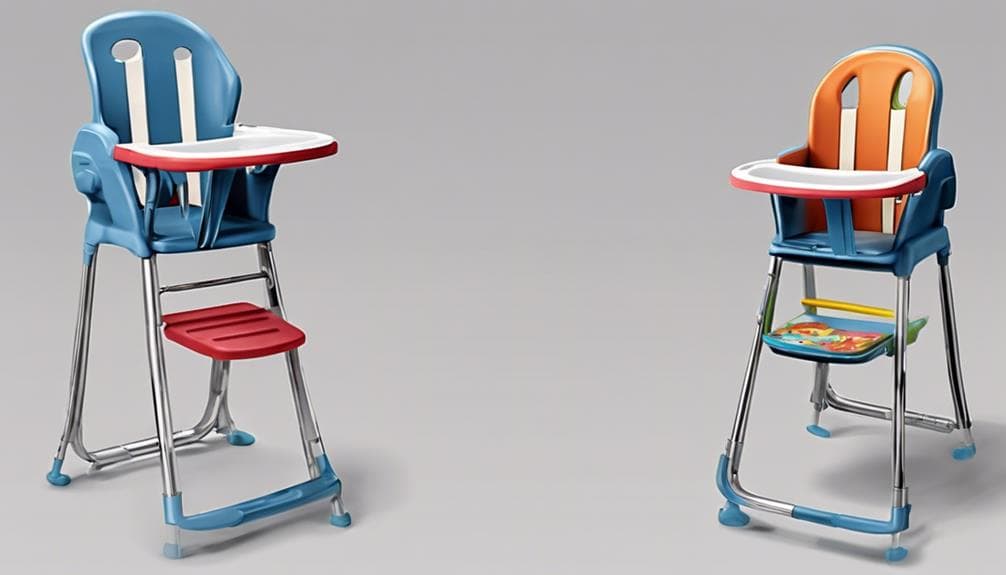
Keeping your high chair clean and well-maintained is important for ensuring a safe and hygienic mealtime environment for your child.
To maintain cleanliness and hygiene, it's recommended to clean the high chair regularly with mild soap and warm water. Wiping down the tray, seat, and harness after each use can help prevent the buildup of dirt and germs.
Checking for loose screws or parts that may need tightening is vital to make sure the high chair remains sturdy and safe for your child. It's also essential to inspect the high chair for any signs of wear and tear, addressing any issues promptly to maintain its functionality.
Storing the high chair in a dry and secure location when not in use can help prolong its lifespan. When it comes to product recommendations, opting for specialized accessories and customization options can make cleaning and maintenance easier.
Following these best practices and seeking expert advice when needed will help you keep your child's high chair in top condition.
Community Recommendations and Reviews
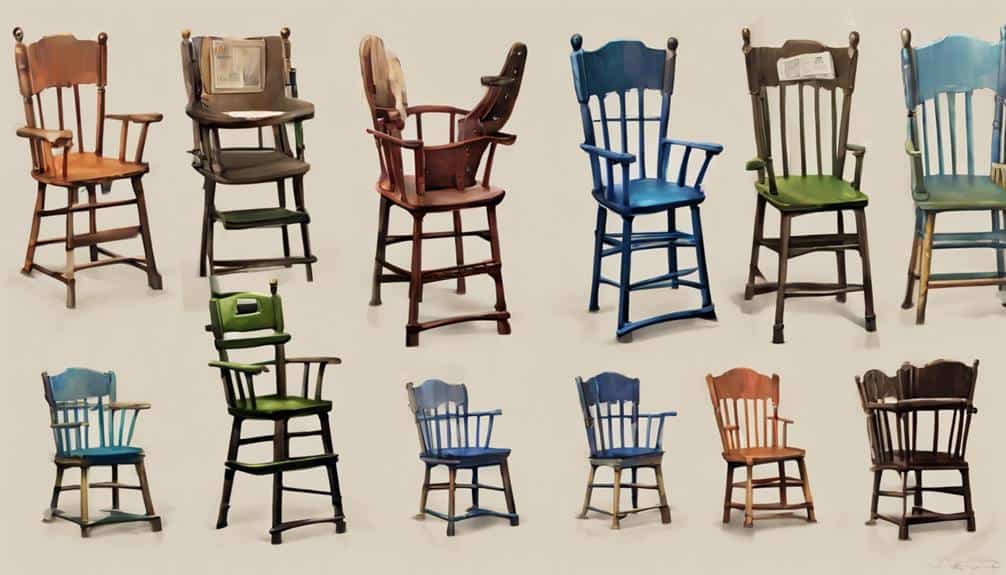
Regularly seeking advice from fellow parents and professionals can provide valuable insights on high chair options suitable for older autistic children, fostering a supportive community for making informed decisions. When considering high chairs for older autistic children, community support and recommendations are invaluable.
Here are some ways community insights can help in choosing the right high chair:
- Product Comparisons: Comparing different high chair options recommended by other parents and professionals can help narrow down choices based on specific needs and features.
- User Experiences: Hearing about the firsthand experiences of other parents who've used certain high chairs can provide practical insights into the usability and effectiveness of the products.
- Safety and Comfort: Gathering feedback on the safety measures and comfort levels of high chairs from the community can aid in selecting a chair that promotes a secure and pleasant mealtime experience for older autistic children.
Frequently Asked Questions
How Old Can a Child Be in a High Chair?
I believe a child can typically use a high chair until around 3 years old, but factors like size and development play a role. High chair alternatives, age-appropriate seating, and moving from a high chair are essential considerations for older children.
Should a 4 Year Old Be in a High Chair?
Should a 4-year-old be in a high chair? Moving to a regular chair promotes independence and social skills, ensuring safety and comfort while considering sensory benefits. It's crucial to choose suitable seating options for developmental needs.
What to Use When Toddler Outgrows High Chair?
When a toddler outgrows a high chair, consider adaptive seating options like booster seats with harnesses for added security. Look for solutions that support sensory integration and provide comfort. Explore different seating options that can grow with the child.
How Long Can a Child Sit in a High Chair?
As a parent, I understand the importance of considering sitting duration and health implications for my child. Exploring alternative seating options while being mindful of behavioral considerations and sensory needs is important for their comfort and well-being.
Conclusion
As I reflect on the importance of choosing the right high chair for an older autistic child, I'm reminded of the saying, 'A stitch in time saves nine.'
By investing in a secure and comfortable high chair that meets their unique needs, we can create a positive and peaceful mealtime experience for both the child and their caregivers.
Remember, a well-chosen high chair can make a world of difference in the daily routine of a child with autism.







